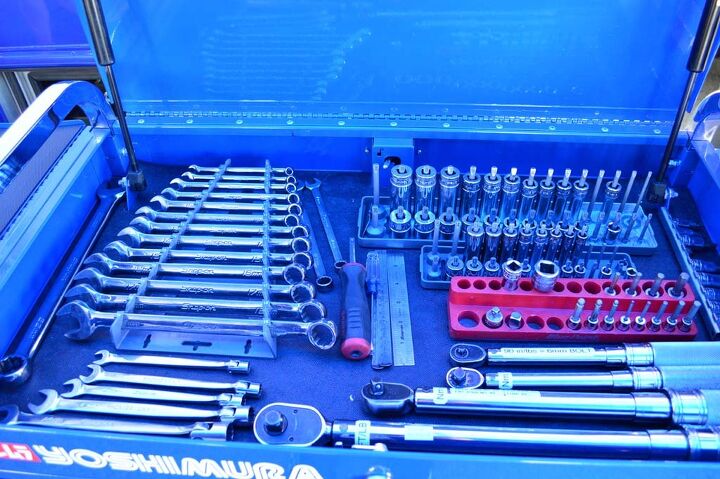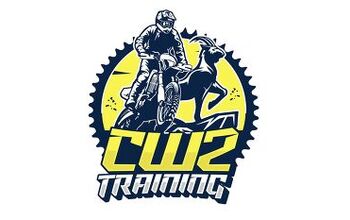Top 10 Differences Between A MotoAmerica Superbike and A Stock Literbike

When it comes to production motorcycle racing – that is, bikes you and I can buy at a dealership – building a Superbike is the highest level you can reach. While the bikes may look fairly similar to the bike you have in your garage, underneath the fancy paint job are a number of modifications designed specifically to make bike and rider lap a racetrack as quickly as possible.
For this week’s Top 10, we take a look at the Yoshimura Suzuki GSX-R1000s raced in the new MotoAmerica series by Jake Lewis and Roger Hayden, to see some differences between a top-level Superbike and a standard GSX-R1000. You might already know Superbike engines get massaged to make 200-plus horsepower, which your standard Gixxer doesn’t have. Instead we’ll look at other aspects of the Superbike to spot some lesser known differences. Luckily for you, many of these parts are available to purchase through Yoshimura should you want to add a bit of exotica to your GSX-R.
10. Tools
Sure you have tools, but are all of them specifically suited for a particular part of your bike? And are they organized this well? In talking with the Yosh mechanics, I was told the most used tool in the box are the T-handles (of course, they aren’t pictured here). They allow for quick disassembly or reassembly of different parts of the bike without the need to use a separate socket and wrench. In the event of a complete teardown and rebuild (like in a crash), then the bulk of these tools are used. The Yosh boys say they can strip a bike down to the frame and put everything back together again in about six to eight hours. Impressive stuff.
9. Seat Padding
Your standard GSX-R1000 seat is soft and padded, at least compared to a proper racing motorcycle. Here we see Jake Lewis’ office chair. As you can see the padding is minimal, since racers move from side to side multiple times per lap. Comfort isn’t a priority, and feeling the bike underneath is more important. That hump of padding at the rear? Lewis prefers to have that extra bit of foam to help keep him properly positioned on the bike when he tucks on the straights.
8. Carbon Fiber Fairings
Weight is the enemy of racing motorcycles, and teams use whatever tactics they can to put production bikes on a diet. One of the ways the Yoshimura Suzuki team cuts about 80 lbs from a standard GSX-R1000 is by replacing the stock plastic fairings with these carbon fiber bits. The weight savings might only be a pound or two, but in racing every little bit counts.
7. Exhaust
Yoshimura is synonymous with exhaust systems, especially for Suzuki GSX-Rs, and that’s no exception here. Yosh’s latest Alpha Race System exhaust is fitted to the Superbikes of Hayden and Lewis, and not only does it shed weight compared to the standard system, it also helps boost power. All while looking incredibly stunning with its carbon fiber covers. Like the way this looks? Get one for your bike directly from the Yoshimura website.
6. Forged Aluminum Wheels
Another weight-saving method is replacing the stock cast aluminum wheels with forged aluminum bits. Not only do they save weight, but it also reduces rotating mass, improving every aspect of performance. Of course, if you’re a performance nut, you already knew that. What’s more interesting is the fact that the Superbike teams used to be able to fit forged magnesium wheels for even greater weight savings and performance. Rule changes have forbidden the use of magnesium wheels, so forged aluminum it is.
5. Top Shelf Suspension
Suspension is a major area where racing motorcycles differ from their production counterparts. While the standard KYB units on the production GSX-R are very capable, they don’t hold a candle to top-shelf Ohlins bits, like this TTX shock. Of course, with enough cash you can get your own TTX shock for your bike. What’s unique here are the sensors used to measure suspension travel (and probably other things the team keeps secret). If you look closely behind the shock reservoir, you can get a glimpse of a black rod and its associated wire. Shock travel is among the many data points the team looks at to extract maximum performance from the bike.
4. Custom Shock Linkages
Chances are you likely haven’t paid much attention to the rear suspension linkage on your GSX-R, but if you’re serious about your track riding, maybe you should. The stock stuff isn’t maximized for track use, these custom Yosh linkages (which you can purchase) modifies the rear suspension geometry for better traction. When every second counts, no stone goes unturned, and these linkages might give the little bit extra Hayden or Lewis might need.
3. Fork Coating
Under the MotoAmerica Superbike rules, front suspension must retain the stock fork tubes. However, teams are allowed to modify the internals, and while we can’t see what’s inside the Yoshimura GSX-R1000 Superbike fork, one thing we can see is the blue hue from the fork tube. This is a special coating which decreases friction as the fork moves up and down. Note also the sensors: there’s a rod-like sensor that measures fork travel, similar to the unit seen on the rear shock, as well as a wheel speed sensor (the wheel speed ring in the brake carrier, as well as the bung tapped into the brake caliper mounting point) used for the bike’s traction control system.
2. Buttons
Like it or not, taming over 200 horses requires a sophisticated level of electronics. During a race the riders are also on-board technicians tasked with making sure the bike makes it to the end while still going as quickly as possible. To help do this, they can press certain buttons to either modify power delivery, traction control, and other parameters. Note the red dial above the buttons on the left bar ( click here for a closer look), used to adjust the brake lever position throughout a race. Note also the brake lever guard to help prevent accidental applications of front brake in the event of a collision.
1. Jake Lewis And Roger Hayden
Of course, the most important feature the stock GSX-R1000 is missing are riders like Roger Hayden (left) and Jake Lewis (right) piloting them. The youngest brother in the Hayden family, Roger is an AMA Supersport champion and AMA Superbike race winner. Lewis, the 2012 AMA Pro Supersport East champ, is making the jump to Superbikes this year after spending the past few seasons on 600s. Fun fact: Lewis and Hayden are not only teammates, but also roommates.

Troy's been riding motorcycles and writing about them since 2006, getting his start at Rider Magazine. From there, he moved to Sport Rider Magazine before finally landing at Motorcycle.com in 2011. A lifelong gearhead who didn't fully immerse himself in motorcycles until his teenage years, Troy's interests have always been in technology, performance, and going fast. Naturally, racing was the perfect avenue to combine all three. Troy has been racing nearly as long as he's been riding and has competed at the AMA national level. He's also won multiple club races throughout the country, culminating in a Utah Sport Bike Association championship in 2011. He has been invited as a guest instructor for the Yamaha Champions Riding School, and when he's not out riding, he's either wrenching on bikes or watching MotoGP.
More by Troy Siahaan






































Comments
Join the conversation
I find the most striking difference between superbikes and stock ones are stickers...;)
I wish they would drop all the electronic gadgetry and go back to elementary controls,highsides be damned.
Interesting article. Yamaha is going to own this season though, the new R1 has the best electronics package and it has Josh Hayes ;)